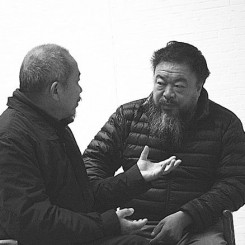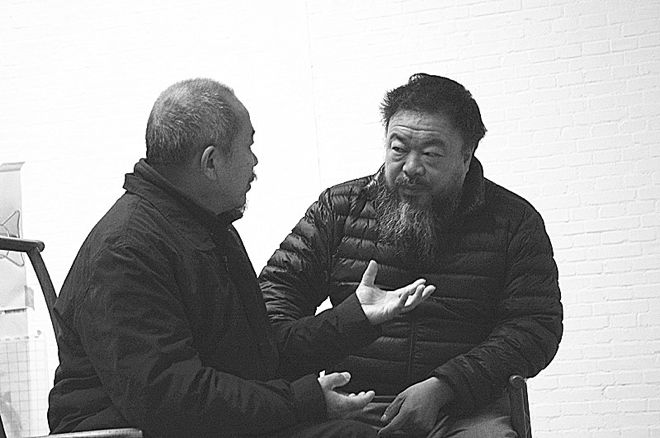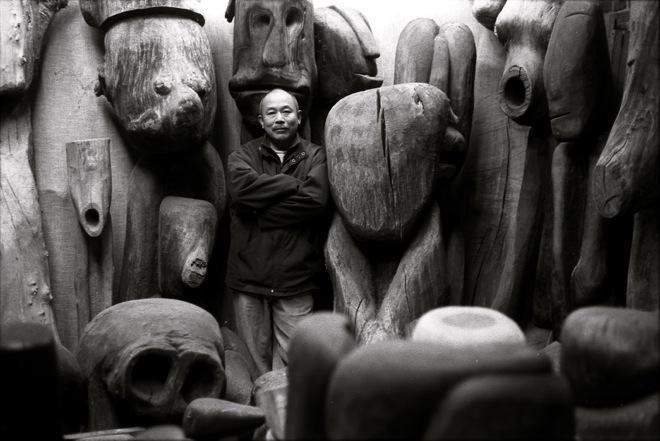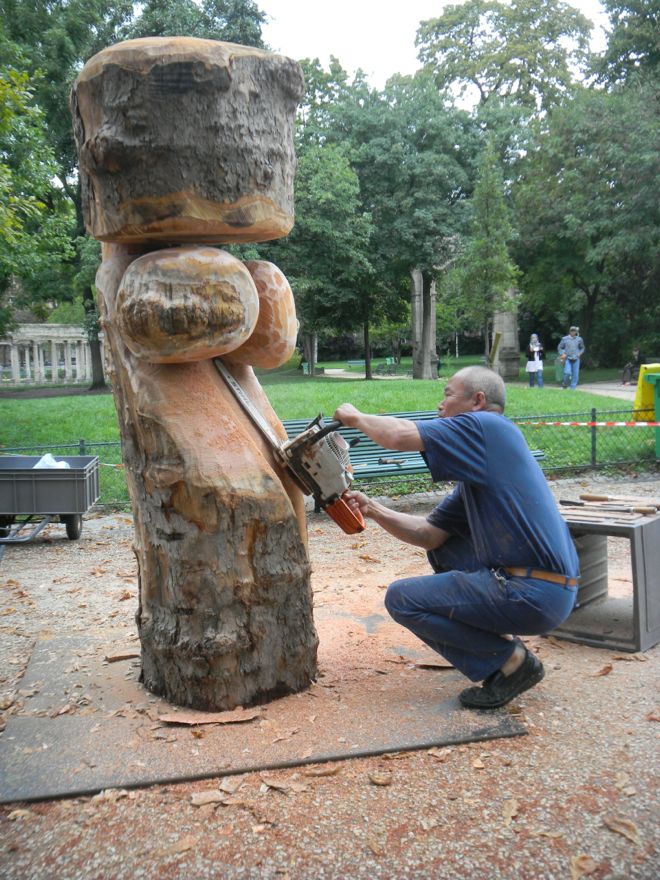(Bilingual One Act Play)
“The Male Artist and Female Art”: Wang Keping AND Ai Weiwei—A New York Affair
Writer: Wang Keping
Characters: Female artist, male artist, translator, visitors
Location: A small room next to the main hall of the art museum
—————
Some new artworks are on display in the hall in the background.
There are two chairs and a small table in the room, and a row of chairs and a TV by the entrance.
The spectators come in and out. Some are waiting by the door of the small room and watching TV.
The female artist is taking notes in the small room.
Several groups of visitors walk in and out of the room in order, with different expressions.
The male artist and his translator enter the hall and look at the works on display. While walking towards the doorway, the translator whispers and explains to the male artist the text on the door. They go to sit in the chairs and wait.
(A middle-aged woman opens the door and entered the room.)
(W: Middle-aged woman, F: Female artist, M: Male artist, T: Translator, V: Spectator with a video camera, E: Elder lady)
W: (to the female artist) Hello.
F: Hello.
(The middle-aged woman runs around in a circle in the room.)
W: Only you?
F: Yes.
W: That’s simple. Is this some sort of joke?
F: No.
W: Are you exhibiting yourself?
F: Yes.
W: Sounds interesting… That’s easy. Hope I didn’t interrupt you, did I?
F: No, please have a seat.
W: Thank you. I’m only staying for a minute. There are a lot of people waiting to see you outside. I come to museums often. It’s not that I don’t like new things, but it’s doing my head in. I have a question I’d like to ask for some advice if I may.
F: (picks up a piece of paper from the small table) Excuse me, could you sign here please?
W: (takes the paper and reads it through) Of course. (Writes her signature) It says, “Life is art” on the door. Do you mean this?
F: Yes.
W: Is life art?
F: Life is art.
W: So is art life?
F: Yes, art is life. Life is art.
W: (Sighs), but my life isn’t art. There is no art in my life at all. My life is boring, really boring, and meaningless…
F: If you can discover that life is art, it can change your life.
W: I am different from you. You are an artist. I only live my life. Life is boring. I am different from you…
F: I am the same as you. I am also an ordinary person. By coming here you have come to an ordinary person’s home. Let’s sit down and have a chat. We will get to know one another and become friends.
W: I don’t have any friends. I am alone. I am lonely. Even my cat runs out every day. I would like art for art’s sake, but I know nothing about art.
F: If you think your life is art, it is. To create your life is to create art. You don’t have friends. Why don’t you go and look for some and get to know more people? From now on, if you get to know a stranger by day, three hundred and sixty five days, you will get to know three hundred and sixty five people. There will be someone amongst the three hundred and sixty five people who becomes your friend. This is a concept of performance art. If you record your experience, it can be introduced in the museum as an exhibition in the future.
W: Yeah, yeah. Thank you. Goodbye. Thanks and goodbye…
F: Goodbye. Thank you.
(The middle-aged woman opens and shuts the door, and exits the stage.)
(The awaiting visitors enter gradually.)
(One visitor with a video camera enters through the door.)
V: Hello.
F: Hello.
V: Please may I…? (Holding the video camera)
F: Of course, please.
(The spectator who holds the video camera leaves the room.)
(The male artist and his translator open the door and enter the room.)
M: Hello.
T: Hello.
F: Hello.
(The male artist looks at the female artist and looks around the room.)
T: (To the male artist) How is it? Open your eyes. This is live modern art for real.
M: And it’s very beautiful. Will she really sit here for a year?
T: The contract she signed with the museum has been put to paper.
M: A brave warrior.
T: Well, don’t miss the boat.
M: Can I talk to her?
T: Of course, she is waiting for you. (To the female artist) Excuse me, the gentleman would like to talk to you if he may?
F: My pleasure. Where are you from?
T: He just came from China. I’m his friend, and his translator at the moment.
M: I am very interested in what you do.
T: (Translating)…
(The translator keeps a sense of humor in both languages to translate the conversations between the male and female artists as below.)
F: I would also be interested in the thoughts of my audience.
M: It’s the first time I come across this kind of art. Perhaps I don’t understand, but it seems very simple, very simple but somehow mysterious.
F: Please sit down. I’m sorry. The museum has a rule: if you would like to talk to me, you need to sign the contract first.
T: Why? Do we need to pay for it?
F: No, please don’t be nervous. It is precisely to avoid the payment. Money is the thing most likely to spoil the mood. There’s nothing to do with money. The contract states that you agree with what I say and do here, and you won’t sue me in court.
T: Ah, okay. But to be fair, you shouldn’t sue us in court either.
F: Ah, agree.
(The translator took a pen and paper.)
M: Are you going to sign it? Please be careful. She seems very tough.
T: Not to worry, I can be tough too. (Writes his signature)
M: Then I’ll sign it. You will take care of me if anything happens anyway.
F: What did he say?
T: He said he… he is very tough.
F: I can tell. He has got bright eyes.
T: In Chinese we’d say you’d been dazzled.
F: No, no, no, I didn’t mean that. Perhaps, maybe, but I feel the artists’ eyes are always so eager.
M: It depends on what he sees.
F: See the money – or a woman?
M: It depends on what kind of woman.
T: He’s eyes are brightening up when he sees a woman like you.
F: Are you an artist?
M: Maybe.
F: I looked at your hand – are you a sculptor?
M: If you think so.
F: A sculptor is more grounded than a painter. What kind of sculpture do you do? Abstract? Figurative?
T: Mainly the human body, female body.
F: Oh, there are so many women on the planet, and you want to create more? Wouldn’t the natural and real ones be better?
M: Even the most beautiful flowers will eventually wither. I seek eternity.
F: There is nothing eternal in the world. The transient nature makes it more precious. Why do you only consider it as art once the living are dead?
M: If living is art, there’s no need for artists to do what they do. If there’s no need for them to do it, then anyone can do it.
F: If there is no need, then it has reached its peak. If anyone can do it, then it depends on who discovers it first.
M: What do you think, in your opinion, is the concept of art?
F: If there is endless art, then there are countless conceptions of art.
M: Do you think there are boundaries between life and art?
F: I think life and art have no boundaries.
M: Do you think you are a work of art?
F: Why not? Today, be it a painting, a sculpture, a bundle of twigs, a pile of rubbish, they are all equally art. A men’s urinal is on display in a museum as a work of art; so is a woman sitting in an art museum.
M: What is the difference between a woman sitting in a museum and her sitting at home?
F: Actually there’s no difference.
T: (To the man) isn’t she saying that there is hardly any difference between her sitting here and sitting on your bed?
M: Mmm, there are meanings between the lines!
(The male artist looks the female artist up and down.)
T: At your museum, there are signs everywhere that read ‘Please do not touch the artwork’. Do you have them here?
F: No, no need.
M: Does that mean you can touch?
F: Ah – you can (reaches out her hand)
(The male artist touches the female artist’s hand.)
F: You have powerful hands.
M: I am a manual laborer, moving bodies around all day.
F: Dead or alive?
M: Dead and alive are all the same. They are all works of art. I like to touch and feel my artworks everyday.
F: Do you do the same when you meet a girl?
M: Why not? I like all good things. Oh, I like all things art.
F: I’ve never had a visitor like you before.
T: (To the man) It’s love at first sight.
M: I don’t know your kind of art. It’s the first time – can I see? Can I touch? (Continues to feel her by moving his hands up and down)
F: This is not eternal. (Falling onto the male artist)
M: Transient is more precious.
F: Do you like it?
M: Ah, I don’t think the artwork would object to people liking it.
F: If it’s true, why not?
T: (To the man) Don’t miss the boat. You mustn’t think twice at the critical moment. (Turns around facing back towards the wall and continues to translate)
(to the male artist) Give him an inch and he’ll take a mile.
F: Your hand is cold.
M: Your body is burning.
F: Please don’t go too far.
M: But there’s no point in creating anything if I doesn’t push the boundary.
F: It’s in a museum.
M: There’s no difference between being in a museum and at home.
F: You are simply out of control.
T: We have made it clear; the law here does not bind us. You make life into art, and he puts the art into life.
F: No, life is art, and art is life.
M: Now I fully agree. Wu Suo Wu Wei is life. Wu Wei Er Wei is art.
F: What do you mean?
M: “Wu Suo Yu Wei” [1] means to do whatever one pleases; such is life. “Wu Wei Er Wei” [2] means inaction, to let things take their own course without any external pressure; such is art.
F: It is well said.
M: Well done is better than well said.
F: You are so strange.
M: It’s not strange at all.
F: You have no disguise. You are completely natural.
T: Too natural is too artful.
F: Too artful is just brilliant.
(The male and female artist kiss.)
(Suddenly the door is pushed open, an elderly lady standing by the door. The rest of the audience take a glimpse inside the room.)
(The male artist quickly turns around to hold the female artist in his lap and hides himself behind her, making only his lap visible.)
E: What are you doing? We have been waiting for so long outside!
F: Please close the door.
(The elder lady closes the door.)
F: (standing up from the male artist’s lap) if you were not to hide yourself just now, it might be more of an art. Please excuse me; we cannot have any more time. Thank you. I hope there will be an opportunity to see you again.
M: Thank you. Goodbye, bye, bye.
T: Goodbye.
(The translator pulls the male artist away.)
F: (taking notes) it was the most interesting day today. A shame! Why didn’t I video record it just now?
Postscript:
This is a script, and also a note after visiting an exhibition—a dialogue for artistic discussion. In fact, it can be called “conceptual art”, an “artistic concept”, “performance art”, and an “artistic performance”.
It was also originally a true story. The time was the morning of the December 1, 1985. It took place at a museum in New York. “Female Art” was the performance artist Linda Montano who was very active then, and the translator is Ai Weiwei. The sculptor is, naturally, myself. The artwork Linda presented was one person sitting alone in her room in the museum, as an ordinary living person, to meet and talk to the audience.
This bilingual one act play has been performed in Chinese and English, and in Chinese and French. Because the roles in the play communicate through the translator in two languages, it can be understood by both Chinese and international audiences.
The translation in the script is very important on stage. The actual lines are elaborate, which allows a variety of possibilities for performance.
The script was first published in May 1987 by the Lion Art magazine in Taiwan.
It took ten years to make into a play, after several amended versions.






